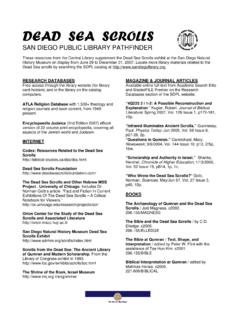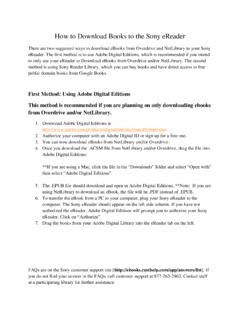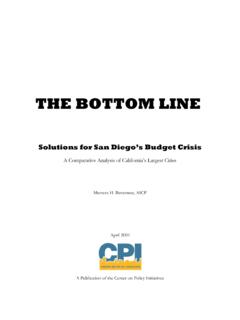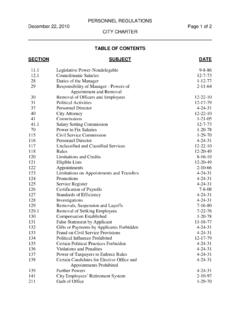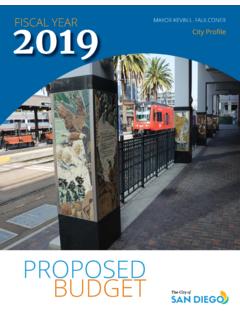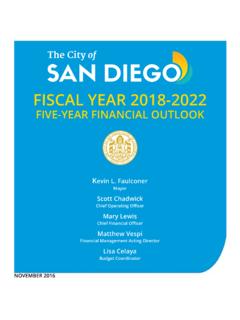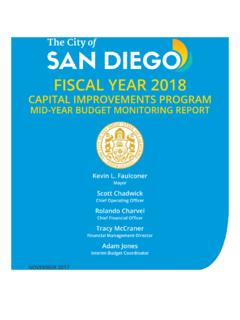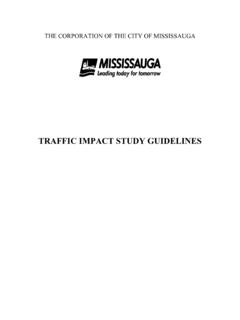Transcription of TRAFFIC IMPACT STUDY MANUAL - San Diego
1 TRAFFIC IMPACT STUDY MANUAL JULY 1998 City of San Diego TRAFFIC IMPACT STUDY MANUAL FINAL JULY 1998 This information, document, or portions thereof, will be made available in alternative formats TABLE OF CONTENTS PREFACE 1. INTRODUCTION Need and Purpose ..1 Review Objectives ..1 Who Should Prepare TRAFFIC IMPACT Studies? ..1 Who Should Review TRAFFIC IMPACT Studies? ..2 Standard Review Ethics and 2. INITIATING TRAFFIC IMPACT STUDIES Warrants for Extent of STUDY Area ..5 Staff Consultations ..6 Screen Check Procedures ..7 3.
2 CONTENT AND FRAMEWORK Selection of Horizon Project Phasing ..9 Peak TRAFFIC Background STUDY Area Field Reconnaissance and Data 4. NON-SITE TRAFFIC Build-up Method Using Specific Community Plan, Regional or Subregional Modeled Volumes ..11 Trends or Growth Cumulative Analysis Due to Precedence Setting ..11 5. SITE TRAFFIC GENERATION General Special or Unusual Generators ..12 Driveway Rates Versus Cumulative rates ..13 Adjustments for Developments Near Transit Adjustments for Mixed-Use Developments ..14 6. SITE TRAFFIC DISTRIBUTION AND ASSIGNMENT Trip Distribution ..15 Trip Assignment ..15 Pass-by Trips ..16 Congestion Management Program Procedures.
3 16 i 7. ANALYSIS Total TRAFFIC Estimate ..17 Identification of Impacts and Deficiencies ..17 Acceptable Level of Levels of Significance ..17 Signalized Intersection Signal Warrant Analysis ..18 Unsignalized Intersection Arterial Freeway Interchange Analysis ..20 8. SITE ACCESS AND OFF-SITE IMPROVEMENTS Recommendations ..21 Project Phasing ..21 Intersection Lane 9. ON-SITE PLANNING AND PARKING Access Vehicular Queuing Storage ..23 Internal Vehicular Circulation ..23 Service and Delivery Emergency Vehicle Pedestrian, Transit and Bicycle Considerations.
4 24 LIST OF FIGURES Figure 1 TRAFFIC IMPACT STUDY Requirement Flow LIST OF TABLES Table 1 Allowable Increase in V/C ..6 Table 2 Roadway Classifications, Levels of Service and Average Daily Table 3 Recommended Trip Reductions at Transit Table 4 Recommended Trip Reductions for Mixed-Use Table 5 Significant transportation IMPACT Table 6 Inputs and Assumptions for Signalized Intersection LIST OF APPENDICES Appendix 1 Screen Appendix 2 Ramp Meter Analysis ..28 Appendix 3 Parking Appendix 4 Intersection Lane ii PREFACE This MANUAL was prepared and updated by the City's transportation Development Section of the Land Development Review Division of the Development Services Center.
5 Procedures addressed in this MANUAL include: Procedure for determining the type of TRAFFIC IMPACT STUDY needed: computerized or non-computerized Requirements for performing TRAFFIC IMPACT studies The MANUAL was originally prepared to replace Department Instructions formulated in 1987 regarding TRAFFIC IMPACT STUDY procedures. These instructions had become obsolete in many areas and had been replaced by unwritten practices that reflected changing legislation, updated analysis techniques and new staff with varying perspectives. This led to a sense of confusion among consultants. A meeting was held in November 1992 to solicit feedback from TRAFFIC consultants on City procedures and reviews.
6 The lack of predictability was a universal complaint. It had become common for STUDY preparers to throw together an incomplete draft STUDY simply to determine staff requirements for their particular STUDY . The City embarked on an organization-wide effort to improve the development review process. As part of this effort, transportation Development Section staff began to rewrite the above mentioned Department Instructions. All area TRAFFIC consultants were invited to serve on a task force to provide input and direction to staff on the TRAFFIC IMPACT STUDY process. It was decided that the Department Instructions would be replaced with a TRAFFIC IMPACT STUDY MANUAL that would be more user friendly and easily updated to reflect new methodologies and practices.
7 The original TRAFFIC IMPACT STUDY MANUAL was produced in August 1993. Equally important to the clearly defined process is an aggressive commitment from the reviewers (the transportation Development Section) to embrace a partnership with the landowner/developer and the preparer ( TRAFFIC consultant) to produce a high quality document that adequately serves the needs of all parties. This will also enable the review process to be completed in an expeditious manner. This 1998 update reflects revisions to the City's land development code and improvements in capacity analysis techniques and increases consistency with the City's overall California Environmental Quality Act (CEQA) review process.
8 Iii 1. INTRODUCTION This MANUAL describes the key elements required for preparing and reviewing TRAFFIC IMPACT studies for new and expanding land developments in San Diego . Not all analysis described in this report will have application to each particular STUDY . Applicable analysis will be determined by the transportation Development Section staff, in consultation with the TRAFFIC STUDY preparer. These procedures indicated in this text are not intended to cover every conceivable situation. New procedures and analysis techniques may be needed to evaluate unique situations. Need and Purpose The primary purpose of this MANUAL is to provide guidance to consultants on how to prepare TRAFFIC IMPACT studies in San Diego .
9 It is intended to ensure consistency among consultants, predictability to the preparer, consistency among reviewers and conformance with all applicable City and state regulations. Every attempt was made to ensure consistency with national practices prescribed in TRAFFIC ACCESS AND IMPACT STUDIES FOR SITE DEVELOPMENT, Institute of transportation Engineers, 1991 and current local practices. This MANUAL generally memorializes current practices. TRAFFIC IMPACT Studies are intended to identify the transportation impacts of proposed development projects and to determine the need for any improvements to the adjacent and nearby road system to maintain a satisfactory level of service, safety and the appropriate access provisions for a proposed development.
10 Review Process Objectives Ideally, the review process should be iterative and should begin when the development's planning is initiated, not after a development has been planned and a TRAFFIC STUDY completed. This will ensure that City guidelines and requirements are met while allowing the landowner/developer's goals to be accomplished. It is recommended that the developer, STUDY preparer and staff reviewer meet at the earliest possible point in the STUDY process. Who Should Prepare TRAFFIC IMPACT Studies? TRAFFIC IMPACT studies shall be prepared under the supervision of a qualified and experienced TRAFFIC Engineer who has specific training and experience in TRAFFIC related to preparing TRAFFIC studies for existing or proposed developments.

